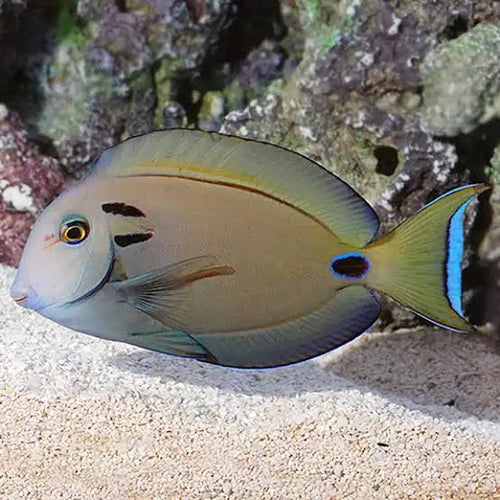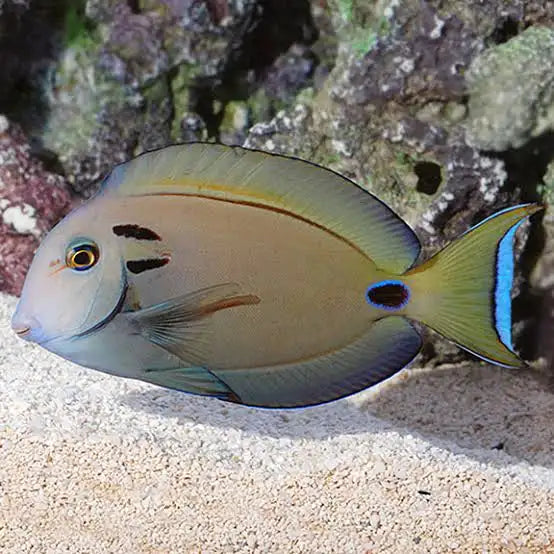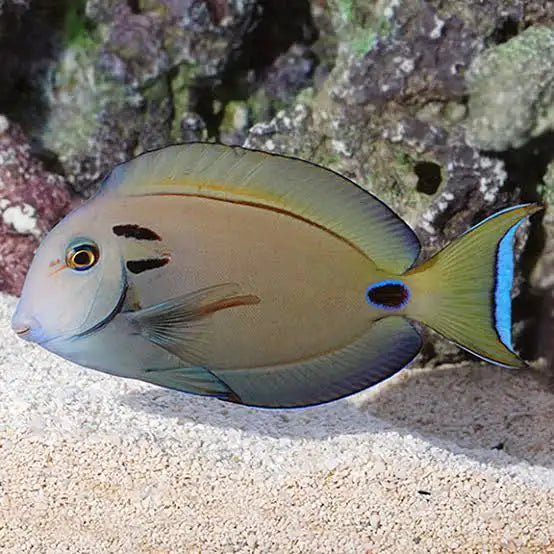Lieutenant Tang
Lieutenant Tang
check_circle Fast Shipping
check_circle Quality Products
check_circle Affordable Price
Reach out to us on ''available to order'' items via WhatsApp or email
Low stock: 1 left
Couldn't load pickup availability

Lieutenant Tang
package_2
Product Description
Product Description
Lieutenant Tang Overview
-
Common Name: Lieutenant Tang
-
Scientific Name: Acanthurus tennentii
-
Also Known As: Tennent’s Tang, Doubleband Surgeonfish
-
Family: Acanthuridae (Surgeonfish/Tangs)
-
Origin: Indian Ocean to Western Pacific – including Maldives, Sri Lanka, Indonesia
-
Size: Up to 10 inches (25 cm)
-
Lifespan: 8–15 years in captivity with proper care
🌈 Appearance
-
Body Color: Bluish-gray to olive base with a distinctive dark vertical band behind the eye and a lighter vertical band just behind it (hence "lieutenant")
-
Tail Fin: Can have a blue or white margin
-
Scalpel: Like all tangs, they have a sharp defensive spine near the base of the tail
-
Juveniles: More brownish or dull with less defined banding
🏝️ Natural Habitat
-
Found in lagoon and reef slope areas
-
Grazes constantly on algae and biofilm
-
Often seen singly or in small groups in the wild
🐠 Aquarium Care
Tank Requirements:
-
Minimum Tank Size: 125 gallons (475+ liters) — needs lots of swimming space
-
Aquascape:
-
Large open areas for swimming
-
Plenty of live rock for grazing and shelter
-
-
Water Movement: Moderate to strong
-
Lighting: Moderate to high (helps support algae growth)
Water Parameters:
-
Temperature: 74–80°F (23–27°C)
-
pH: 8.1–8.4
-
Salinity: 1.023–1.025
-
Nitrates: <20 ppm preferred
-
Stability: Highly important — tangs can be sensitive to parameter swings
🍽️ Diet
-
Feeding Type: Herbivore (will accept omnivore foods)
-
Diet:
-
Primarily marine algae and seaweed (nori sheets)
-
Spirulina-based flakes and pellets
-
Frozen herbivore blends
-
Occasional mysis or brine shrimp
-
-
Feeding Frequency: 2–3 times daily
-
A well-fed tang is less aggressive and more resistant to disease
🤝 Behavior & Compatibility
-
Temperament: Generally peaceful for a tang, but can be territorial with other tangs
-
Reef Safe: ✅ Yes — won’t harm corals or most inverts
-
Tankmates:
-
Peaceful to semi-aggressive fish
-
Avoid other Acanthurus tangs unless in a large tank
-
Can mix with tangs of different genus (e.g., Zebrasoma, Ctenochaetus) in very large systems
-
Works well in reef communities with clownfish, wrasses, anthias, etc.
-
✅ Pros
-
Beautiful, bold pattern
-
Active swimmer — adds movement to the tank
-
Excellent algae grazer
-
Generally hardy once established
-
Reef safe
❌ Cons
-
Needs a large tank due to size and swimming needs
-
May become territorial with other tangs
-
Prone to marine ich (Cryptocaryon) — quarantine is strongly recommended
-
Requires frequent feeding to prevent aggression and stress
💡 Tips for Success
-
Use a seaweed clip with nori daily to satisfy grazing needs
-
Introduce to the display tank after more aggressive tangs, if mixed
-
Keep stress low with stable water and high oxygen levels
-
Provide UV sterilization or ozone for disease prevention
-
Quarantine all new additions to avoid parasites
Summary
| Category | Details |
|---|---|
| Difficulty | Intermediate |
| Temperament | Peaceful to semi-aggressive |
| Max Size | ~10 inches (25 cm) |
| Tank Size (Min) | 125 gallons |
| Diet | Herbivore (needs algae & nori) |
| Reef Safe | ✅ Yes |
| Compatible Tangs | Caution with other Acanthurus species |
| Activity Level | Very active swimmer |


